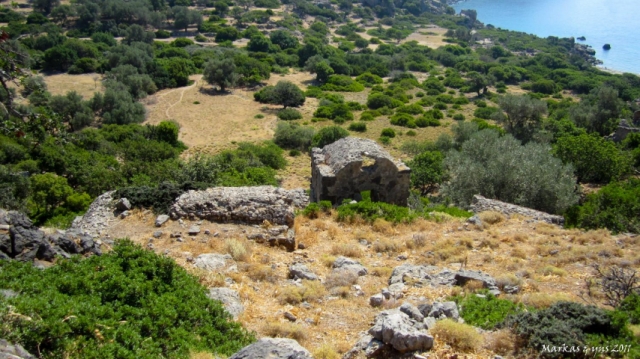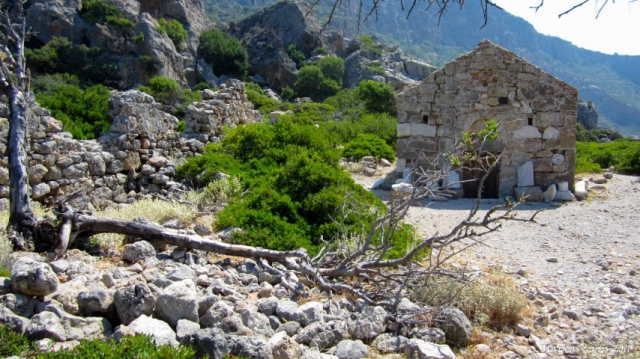Your Position:
Unknown
Άγιος Γεώργιος
Νομός: Χανίων
Προτείνετε
Η γνώμη σας

Αν θέλετε να μας πείτε την άποψη σας γι αυτήν την τοποθεσία, θα σας παρακαλούσαμε να γράψετε ένα σχόλιο.
Σχολιάστε:
Μέρη κοντινά με Άγιος Γεώργιος
The "pyramid" of Chania (in fact cone) is carved into a rock and is a unique monument since there is no mention of such a building - construct. Formal studies, surveys or excavations have not done so far.
The monument itself is unknown in the world, and therefore it is no possible the know the contruction period or age. It is located near Rodovani village and Elyros or Eliros archaeological site, at an altitude of 290 meters above the south coast of Chania prefecture and about 20km before arriving in Sougia coastal village.
Inside the cone has carved a room with dimensions of 2.20 m x 2,10 m. and a height of 1.40 m approximately, which goes from one entrance is on West (at 253 ° C.) dimensions 1.2 m x 0,7 m The circumference of the cone is approximately 16 meters and the height from the top to the floor of the chamber is about 4.6 meters. The circumference of the base is about 29 meters.
The monument itself is unknown in the world, and therefore it is no possible the know the contruction period or age. It is located near Rodovani village and Elyros or Eliros archaeological site, at an altitude of 290 meters above the south coast of Chania prefecture and about 20km before arriving in Sougia coastal village.
Inside the cone has carved a room with dimensions of 2.20 m x 2,10 m. and a height of 1.40 m approximately, which goes from one entrance is on West (at 253 ° C.) dimensions 1.2 m x 0,7 m The circumference of the cone is approximately 16 meters and the height from the top to the floor of the chamber is about 4.6 meters. The circumference of the base is about 29 meters.
Lissos ("Λισσός" in Greek) is an ancient city in south-west Crete, in Agios Kirikos area, near the small village of Sougia, 70 km south of Chania.Lissos and Syia was the harbours of the city of Elyros, the most important ancient city of the area, located near the village Rodovani.
It was established in the Classical period and flourished until the Late Antiquity. Its name was made certain by inscriptions. The early history of the city is unknown. Based on inscriptions and coins of the 3rd century BC, we know the city allied with King of Carthage Maga, and joined the League of Oreians. The koinon of the Oreians was consisted of the cities Lissos, Syia, Poikilassos, Tarra, Yrtakina and Elyros. Lissos had powerful trading and fishing navy.There were discovered ruins of theatre, aqueduct, cemetery, and baths of the ancient times, and Palaiochristian basilicas. In the area, there were also found many votive objects, which are now exhibited at the Archaeological Museums of Heraklion and Chania. In no other city of Crete, apart from Gortys, there were found so many pieces of sculpture. This fact testifies the prosperity and the power of the Asclepieion of Lissos. Lissos has its own coins with the images of Artemis and dolphin and the word LISION (of the Lisians). Lissos and Yrtakina were allies and they had trading intercourse with common currency. Their coins had dolphin or flying dove on the one side, and eight-ray star with the word L/I/S/I/O/N (of the Lisians) on the other.In 1957-58 the city was excavated by N. Platon.Beside the Asklepieion and the Roman necropolis there are also two Greek Orthodox churches: Agios Kyrikos has some nice frescoes and the chapel of Panagia is build with ancient marble blocks.The small beach is a coarse pebble beach. Nobody lives in Lissos nowadays. You can reach it from Sougia by boat or by foot (90 minutes walk).
It was established in the Classical period and flourished until the Late Antiquity. Its name was made certain by inscriptions. The early history of the city is unknown. Based on inscriptions and coins of the 3rd century BC, we know the city allied with King of Carthage Maga, and joined the League of Oreians. The koinon of the Oreians was consisted of the cities Lissos, Syia, Poikilassos, Tarra, Yrtakina and Elyros. Lissos had powerful trading and fishing navy.There were discovered ruins of theatre, aqueduct, cemetery, and baths of the ancient times, and Palaiochristian basilicas. In the area, there were also found many votive objects, which are now exhibited at the Archaeological Museums of Heraklion and Chania. In no other city of Crete, apart from Gortys, there were found so many pieces of sculpture. This fact testifies the prosperity and the power of the Asclepieion of Lissos. Lissos has its own coins with the images of Artemis and dolphin and the word LISION (of the Lisians). Lissos and Yrtakina were allies and they had trading intercourse with common currency. Their coins had dolphin or flying dove on the one side, and eight-ray star with the word L/I/S/I/O/N (of the Lisians) on the other.In 1957-58 the city was excavated by N. Platon.Beside the Asklepieion and the Roman necropolis there are also two Greek Orthodox churches: Agios Kyrikos has some nice frescoes and the chapel of Panagia is build with ancient marble blocks.The small beach is a coarse pebble beach. Nobody lives in Lissos nowadays. You can reach it from Sougia by boat or by foot (90 minutes walk).
The Gorge of Lissos in Sougia is a small but beautiful gorge which starts at the Sougia harbour, south coast, Chania prefecture. The distance from Chania city is 67km.
The walk through the Lissos gorge is easy and takes less than two hours. At the end of the harbour is the entrance to the gorge. A small rock blocks the road but it is easy to overcome this small obstacle after which you continue on the way towards Lissos. Alongside the path you will find a pine-tree forest, which gives a welcome shade in the summertime. After half an hour you pass a very impressive rock.
After some 45 minutes, the path goes uphill and the walk becomes a bit more difficult. Then you end up in a pine-tree forest that ends at a plateau, from which you have a beautiful view over Lissos bay. Subsequently, you can go downhill again and visit the slightly remote temple, the archaeological site and at the end the Lissos beach. Unfortunately, from here there is no other way back to Sougia, except to walk back the same route in reverse order.
The walk through the Lissos gorge is easy and takes less than two hours. At the end of the harbour is the entrance to the gorge. A small rock blocks the road but it is easy to overcome this small obstacle after which you continue on the way towards Lissos. Alongside the path you will find a pine-tree forest, which gives a welcome shade in the summertime. After half an hour you pass a very impressive rock.
After some 45 minutes, the path goes uphill and the walk becomes a bit more difficult. Then you end up in a pine-tree forest that ends at a plateau, from which you have a beautiful view over Lissos bay. Subsequently, you can go downhill again and visit the slightly remote temple, the archaeological site and at the end the Lissos beach. Unfortunately, from here there is no other way back to Sougia, except to walk back the same route in reverse order.
Prodromi is a village in the municipality of Pelekanos, Chania Prefecture, Crete, Greece. The name of the village in 18th century was "Peroudo Vrisi". The current name is from the church of Agios Ioannis Prodromos. It is a nice community unspoiled from tourist exploitation surrounded by natural mountain view beauty of Cretan earth. The area is covered with picturesque hills and beyond them steep mountain-sides in a magnificent landscape. There are protected considerable archeological places like the area of Lissos which is a magnificent location that hosts a Temple devoted to Asklipio (god of medicine) and a natural spring with curing water, a Roman grave yard and one of the first Byzantine Churches in the province of Selino at Chania.
Yrtakina is an ancient city from the prehistoric period with a castle made by Giant Rocks. Main production is based on Olive Oil, Splendid wine from dry rocky fertile ground, and diary products from naturally grown goats and sheep. Main church is Agios Charalambos located near the nice neighbourhood of “Halliliana”.
At the name day the friendly local population organizes a big celebration The village had no modern road till recently but today can be reached with a narrow modern asphalt covered road from one side leading to the near by city of Paleochora. The north approach to the village required a 4x4 off-road car or any other durable car until the end of 2008 where a new asphalt covered road was constructed. This has protected the area, which kept its calm and unspoiled environment.
The Panagia ChurchIn the village of Prodromi, in the location Skafidia, is the Byzantine church of the Panagia. The north road from Prodromi passes below the church, which can be seen from far away on the side of the mountain. The church of the Panagia has tooth-brick decorations on its east side and frescoes by Ioannis Pagomenos dated 1347.







